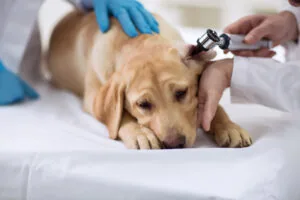Spring Is Here and so Are the Fleas and Ticks!

Spring Is Here and so Are the Fleas and Ticks!
Spring is here, the weather is nice, the flowers are blooming but it also means that the fleas and ticks are also here! Fleas and ticks may be small, but these two tiny creatures have at least one thing in common—they are both parasites that feed on your dog’s or cat’s blood and can cause a lot of discomfort and more serious health problems.
Fleas
A flea is an insect. Even though fleas are wingless and cannot fly, they can jump exceptionally high. Fleas can be difficult to spot right away – they measure 1/16 to 1/8 inches long. With a lifespan of about 100 days, fleas like to settle in and stay in one place. This means once a flea jumps on your pet, it is very likely that it will stay there until it dies. Your pet will provide a flea with everything that it needs to live comfortably – it will feed off of your pet and begin having babies when it finishes eating. For several weeks, they will lay 20-40 eggs a day. These eggs will end up wherever your dog goes, when your pet sheds, it will not just be fur it will also be flea eggs, just waiting to hatch. Fleas prefer heat to cold and are happier in a warmer climate. A flea will make itself at home indoors where it can stay toasty and warm. Fleas don’t always settle into their new home alone, they can carry Bartonellosis and tapeworm that can be passed along to your pet.
Ticks
A close cousin to spiders, the tick is considered to be an arachnid (thanks to their eight legs). It’s bigger than the flea, measuring in at ¼ to 1/8-inches long. Ticks don’t mind moving from animal to animal so they are not very picky about where they set up house. Ticks cannot only be found on cats and dogs, they can be found on snakes, lizards and even humans. A ticks life cycle can last anywhere from 3 months to 3 years. Ticks are picky and will wait to find just the right home. They cannot spend too long on one host. As larvae, nymphs, and adults, they will go from host to host through each life stage. After feeding off a host, a female tick will fall from its host and lay thousands of eggs. Once the tick is finished laying her eggs, it will die leaving behind thousands of eggs to carry on its dirty work. Ticks are happiest in cold climates, and do not mind the winter cold at all. The tick carries plenty of deadly diseases including Lyme disease and Rocky Mountain Spotted Fever.
Parasite Control
The best way to control flea problems is to prevent them from happening in the first place. Fortunately, developments in veterinary parasite control in recent years have made the twofold goal of eliminating fleas on pets and preventing further infestations much easier to achieve. Available for both cats and dogs, new insecticides and insect growth regulators in easy-to-use topical or oral forms not only eliminate any existing fleas, but also work long-term to prevent future infestations. This is accomplished either by killing the parasites before they can reproduce or by preventing their eggs from developing into normal adult fleas. Consult your veterinarian for advice about the proper product for your pet. Furthermore, thorough daily vacuuming of high-traffic areas and frequent washing of your pet’s bedding will also go a long way in reducing the flea population in your home.
Some of the same types of topical or oral products used to control flea infestation are also effective against ticks. Tick collars are also available. Such treatments should be combined with daily examinations and tick removal for those pets, especially cats, who are frequently outdoors in areas with high tick populations. Ask your veterinarian for information about the situation in your locality.
If despite your best efforts at control, you find that fleas or ticks have crawled (or jumped) on board your pet, you will have to use a product that will kill and/or repel the parasites. Once again, you should ask your veterinarian for advice about what the most appropriate product for your pet is. And remember, it is perfectly normal to see live fleas or ticks on a pet immediately after a topical treatment, spray, shampoo, collar, etc. is applied. Many believe that this means the product is not working, but the fleas or ticks have to fully absorb the product before they will be affected, which may take from a few hours to a few days.
Share This Post
Recent Posts
About Shallowford Animal Hospital
Shallowford Animal Hospital and The Pet Spa at Shallowford are dedicated to the exceptional, compassionate care your pet deserves. Pets hold a very special place in our families, and we treat yours like our own.



